Wireless Wide Area Networks (WWANs)
|
|
WWANs have received a lot of attention in recent years. WWANs/mobility services give the user the ability to move around town or around the country while still remaining connected to the Internet or the company intranet. As such, they require extensive infrastructure, like cellular telephony with its numerous tall towers[37] all over town, switches, central offices, and gateways. These networks and systems tend to be the purview of major carriers such as AT&T Wireless, Sprint, Verizon, and so on. WWANs have been around for a number of years (see Figure 1-14),[38] but data support was rather limited and expensive until the late 1990s. Mobile telephones phones are also becoming portable Internet terminals. PDAs, laptops, and data-ready phones benefit from mobile Internet access, although the speeds started out at the low end (compared to LAN connections).

Figure 1-14: The evolution of WWLAN over three decades
As of yet, no single killer application has emerged beyond the basic convenience of mobility because individual interests are varied. For example, e-mail has limits (not everyone wants to read e-mails while shopping at the mall and so on); stock quote/trading via wireless has been available since the mid-1980s. Enterprise applications (secure Web-enabled intranet access to ERP systems via wireless) may be of increasing importance in the near future. Figure 1-15 provides nominal and actual data rates for some WWAN technologies.
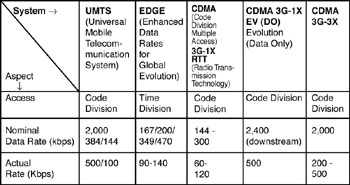
Figure 1-15: Nominal/actual data rates for various technologies
The range of a WAN is typically measured in miles. Communication over such distances requires relatively high-power transmissions and, because of that, a license for a specific frequency band. In most instances, carriers pay a fee for a license to transmit at certain power levels in a particular frequency spectrum. High-power transmission also leads to trade-offs between power consumption and data rates in WWANs. Typical data rates for today's cellular networks are relatively slow due largely to the transmission power needed to reach the cellular tower from a handset. Higher data rates at these same levels of power transmission are impractical using today's battery technologies. 3G cellular systems will have significantly faster data rates; however, to maintain power consumption at reasonable levels, 3G systems will require cellular towers to be much closer together - on the order of hundreds of meters - approaching the coverage of WLANs. Some of these WWAN technologies are those in common use for cellular communications, such as Global System for Mobile Communications (GSM), TDMA, Code Division Multiple Access (CDMA), and others (see Figure 1-16).[39] Unfortunately, there is a real cornucopia of standards, making interworking a challenge, particularly for data applications. Table 1-5 depicts the set of such standards[40] and Figure 1-17 identifies some of the key standards bodies working on 3G.

Figure 1-16: Taxonomy of WWANs

Figure 1-17: Standards bodies involved in 3G
Table 1-5. Table Cornucopia of standards for WWANs
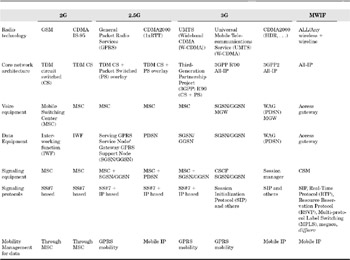
Source: WaterCove Networks
Environments with a highly developed wired network lower the demand for wireless services, just as the availability of cable TV in major urban locations lowers the demand for Direct TV for city dwellers (however, in more rural environments, Direct Broadcast Satellite services are more in demand). This is why demand for web access via cell phones is more pronounced in Asia and Europe. Also, the presence of highly developed wired networks has a downward price pressure on cell phone and wireless charges. Wireless has taken off in countries where telecom charges are high because it is more available and less expensive than the wireline alternatives.
WWANs piggyback on wireless telephone systems. Hence, any discussion of WWANs will entail references to these systems, so a quick review is in order.
European providers have deployed systems based on the GSM standard.[41] In the United States, however, carriers have utilized a variety of standards including CDMA, TDMA, and GSM. TDMA is the most widely used wireless technology in the Americas, but other systems are also used. The plethora of standards forces web developers to duplicate their work to support each protocol and the specific types of devices that use each protocol.[42]
This paragraph provides a snapshot of the GSM history.[43] In the early 1980s, there were several different cellular solutions in Europe, such as NMT 450, Total Access Communications Service (TACS), C-Netz, Radiocom, and RTMI/RTMS. In 1982, the Conférence des Administrations Europèenes des Postes et Télécommunications (CEPT), a group of 26 European telecommunication carriers, established the Groupe Spéciale Mobile (GSM), which is also known as Global System for Mobile Communications, for a pan-European collaboration. In 1984, the GSM project was endorsed by the European Commission, which paved the way for a digital wireless solution for the 900 MHz frequency band. With the rapid increase of mobile communications, pressure was put on the European Communities to adopt the GSM solution quickly. An agreement was reached to reserve the 900 MHz frequency block in member states for a rollout in major European cities in 1993 and a linking in 1995.
On September 7th, 1987, operators from 13 countries signed a Memorandum of Understanding (MoU) in Copenhagen. The new standard was supposed to employ TDMA, a technology supported by Nokia, Ericsson, and Siemens. After validation tests, the MoU operators signed an invitation-to-tender in 1988. In 1989, the European Telecommunications Standards Institute (ETSI) was formed and accorded equal status to administrators, operators, and manufacturers, which resulted in the publication of the GSM 900 specifications in 1990.
The United Kingdom's personal communications network (PCN) decided to adopt the GSM specification for their Digital Cellular System 1900 (DCS 1900) development, which was later renamed GSM 1800. A major problem with the network launches in 1991 was that no GSM terminals were available. Each terminal had to undergo a rigorous approval regime that was not available at that time, but that was needed for international roaming. This resulted in the introduction of interim type approval (ITA) to ensure that terminals would not create problems for the networks, which resulted in the wide availability of terminals in 1992.
In 1992, Australia's Telstra signed on with the MoU and just four years later they had 1 million subscribers, which was 5.6 percent of the population. One year later, GSM had also expanded to India, Africa, Asia, and the Arab world. In 1994, the U.S. Federal Communications Commission (FCC) made the 1,900 MHz band available in the United States. In 1995, the MoU had 156 members serving 12 million customers in 86 countries. At the same time, Phase 2 of GSM and demonstrations of fax, video, and data communications via GSM appeared. One of the most attractive features of GSM is network security, which has encryption for both speech and data. GSM subscribers are identified by their Subscriber Identity Module (SIM) card, which means that a user can put his or her SIM card in any phone and be recognized in the network. At the end of 2001, there were 600 million GSM subscribers worldwide, which is 65 percent of the world's wireless market.
The GSM-ANSI-136 Interoperability Team (GAIT) is working on developing mobile phones that work on both GSM and TDMA networks while providing overseas roaming. This is of interest to companies such as Cingular and AT&T Wireless, which are operators who still have TDMA networks and are currently deploying GSM networks. GAIT Phase 1 is the integration of GSM and TDMA voice and data technology into one handset with the option to select which system to use. The supporting organization is the Universal Wireless Communications Consortium (UWCC). The Consortium was founded in 1996 and works closely with other global organizations like the ITU, 3GPP, and the UMTS Forum.
GPRS is a packet-switched wireless data network that enables data to be sent and received using GPRS devices in a more cost-efficient and quicker way than was possible over the GSM cellular system. Users can enjoy data download rates up to 53.6 Kbps over GPRS compared to 14.4 Kbps via circuit-switched data over GSM. GPRS is a new (2.5G) wireless technology standard that is expected to alter and improve the data services that can be added to GSM-based PCNs. ETSI defined GPRS in 1997 with the goal of providing packet-mode data services in GSM. GPRS is an over-the-air system for transmitting data on GSM networks that converts data into standard Internet packets, enabling interoperability between the Internet and GSM network.
In GPRS, a single time slot may be shared by multiple users to transfer packet data. GSM service providers in North America (which does not have a large market share at this time) and in the rest of the world (ROW) are aggressively enhancing their service capabilities through the support of GPRS for packet data. With GPRS, high-speed wireless access to the Internet, e-mail, and corporate databases can be supported at speeds up to 53.6 Kbps. GPRS wireless technology employs authentication and encryption via standard GSM algorithms. The SIM card (a component of the GSM network) stores the authentication and encryption algorithms, preventing unauthorized users from capturing and deciphering messages.[44]
CDMA is a high-capacity cellular technology that employs spread spectrum technology and a unique digital coding system rather than separate channels to differentiate subscribers. CDMA was developed by Qualcomm and introduced commercially in 1995. In 1999, CDMA was adopted as the basis for 3G wireless systems by the ITU. The CDMA Development Group (CDG)[45] has been established as an industry consortium of companies to develop products and services to assist the adoption of CDMA. CDMA is used as the basis of UMTS and W-CDMA. Future 3G phones will be based on CDMA technology. Enhancing this data capability is the 1xRTT CDMA standard, which forms the basis for one of the 3G wireless standards. 1xRadio Transmission Technology (1xRTT) is designed to support always-on data transmission speeds up to 10 times faster than typically available today up to a maximum of 153.6 Kbps.[46]
With the new GSM, GPRS, and CDMA 1xRTT packet data networks in the United States on track in 2002, a fair number of interesting and useful products should become available to end users in 2003.[47]
Other systems are available and/or evolving. High-speed circuit-switched data (HSCSD) is an enhancement to GSM networks that enables users to send and receive data at higher speeds. This improvement is achieved by increasing the data rate of one channel and providing the option of utilizing several channels at the same time. These enhancements result in speeds of about 60 Kbps. The improved performance makes HSCSD useful to people who want to access the Internet at higher speeds than the current GSM phones offer. The higher data speed per channel is achieved by utilizing a new coding scheme that has lower bandwidth requirements for error correction. A GSM channel provides a bit rate of 22.8 Kbps, but about 13.3 Kbps of this bandwidth is used for error correction. With HSCSD, only 8.6 Kbps is used for error correction. This results in higher speeds in cases where users are close to GSM cells where there is high-quality reception (the need for error correction increases with distance/noise). Several manufacturers already have HSCSD-enabled mobile phones on the market.
Personal digital cellular (PDC) is the dominant cellular network technology used in Japan. PDC is a variation of TDMA. The technology was introduced in Japan by NTT DoCoMo in 1991 and operates in the 800 and 1,500 MHz bands. The upgrade path for PDC to 3G is W-CDMA.
Above the bearer radio channel, carriers and device manufactures have for the most part agreed to support WAP, but WAP-complaint phones and pagers had not made major market inroads by early 2002.
As a specific example of WWAN-based services, recent work has been done to add wireless services to (Palm-based) PDAs. For example, a Wells Fargo's wireless system was contemplated to give customers the ability to check balances, transfer funds, and get alerts and stock quotes. Many people want one converged PDA rather than several devices. Palm OS took the initial lead in the endeavor of adding connectivity to PDAs and published an open operating system (OS). Next Microsoft brought a credible alternative to the market with its PocketPC platform, which offers seamless integration with other Microsoft products and has greater performance and better networking than Palm OS. However, at the time of this writing, Palm still has significant market share. Potential providers have developed the business case that shows acceptable return on investment (ROI) numbers for investing in a wireless infrastructure, predicated on finding some killer app. Real-time stock quotes and transactions on wireless devices or cell phones have been possible for a number of years (over 17 years in the former case). All of these applications are low speed. Figure 1-18 depicts examples of 2G/2.5G data systems.
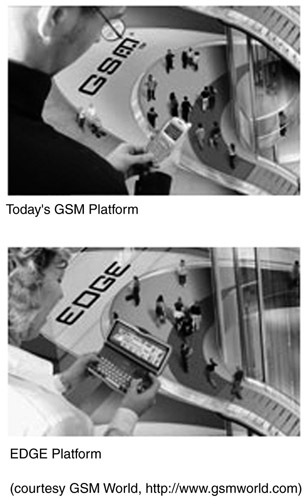
Figure 1-18: Examples of portable terminals supporting hotspot services (Source: GSM World, http://www.gsmworld.com)
3G mobile communications is a concept outlined in a set of proposals called the International Mobile Telecommunications-2000 (IMT-2000) to define an anywhere, anytime standard for the future of universal personal communications. The ITU has given support to two 3G technologies: W-CDMA and CDMA2000. W-CDMA appears to be poised to take the lead in high-speed wireless services. North American providers have leaned in favor of CDMA2000 and Enhanced Data Rates for GSM Evolution (EDGE). The ITU has recommended that 3G wireless devices work on W-CDMA and CDMA2000 networks to make worldwide data roaming possible.
By implementing 3G wireless services, carriers plan to upgrade their infrastructures to high-speed data. 3G supports bit rates as fast as 2 Mbps. Although this is less than the 11 Mbps possible with an IEEE 802.11b WLAN or the 54 Mbps possible with the IEEE 802.11a WLAN, the reach (distance) is much greater with 3G. 3G wireless data services could bring many of the benefits of wireline bandwidth broadband to mobile devices.[48] 3G, however, is not a trivial service to deploy. Particularly in Europe, carriers have made significant investments to acquire the spectrum needed for the services, which has left them cash-strapped for a period of time. Carriers were planning commercial rollouts in 2003 or 2004. The global deployment of wireless has been hampered recently by a downturn in the telecom industry. Market fragmentation is also an issue impacting ubiquitous deployment, particularly in North America. Another retarding factor is lack and/or cost of spectrum.
UMTS is commonly used alongside the term 3G in Europe. This can be confusing, however, as UMTS refers to a specific implementation of W-CDMA within the 2.1 GHz band, which is the frequency allocated for 3G in Europe and other parts of the world. It is an implementation of 3G. UMTS is being developed within a framework defined by ITU, IMT-2000, and the UMTS Forum.[49]
As noted, existing 2G systems offer low data rates, such as 14.4 Kbps circuit-switched services. Besides throughput, other 2G limitations include the fact that the link is not always on and that applications do not have access to a packetized stream, which is intrinsically more desirable for data applications than a circuit-mode link. Some of the early packet-mode services such as Cellular Digital Packet Data (CDPD) and Ericsson's Mobitex have proven to be well suited for application support; these systems will be subsumed by more widely adopted standards, such as GPRS and CDMA 1X. For example, 1x Evolution for Data Only (1xEV-DO) is a CDMA data protocol for faster speeds over dedicated channels. The maximum theoretical data rate is 2.4 Mbps. Although it is unlikely you can achieve the maximum rate, 1xEV-DO should indeed offer significantly faster data rates than its precursors. Currently, 1xRTT (voice plus data) provides speeds of about 40 to 70 Kbps, depending upon the implementation and the operator that is implementing it. Korean subscribers are able to receive the higher data rate. In the United States, Verizon Wireless and Sprint PCS have indicated that they will offer 40 to 60 Kbps at the outset. Korea is pioneering CDMA development and is also manufacturing CDMA hardware.[17] It is possible for Sprint and/or Verizon to offer 1xEV-DO service late in 2003; these carriers are still, however, in the early stages of 1xRTT. This will be the main priority for some time (Sprint PCS will offer 1xRTT service in the second half of 2002 - there are various challenges with cellular data, but the industry is progressing).
CDMA2000 is the name used by the Telecommunications Industry Association (TIA) to refer to 3G CDMA. CDMA2000 now is an IMT-2000 standard and is included in the evolution part from cdmaOne. CDMA2000 1x will double the voice capacity and allow packet-based data transfer speeds of up to 307 Kbps. CDMA2000 1xEV, the next step, will allow data transfer rates up to 2.4 Mbps (1xEV-DO - data only) and 4.8 Mbps in Phase 2 (1xEV-DV - data and voice). The CDG is the advocacy group.[49] To support roaming, carriers need to work out billing and access agreements. Users with EDGE devices may have a harder time achieving roaming.
The evolution process will be complex. The CDMA path to 3G is through CDMA2000 1X and then to 1xEV-DO and 1xEV-DV. The first phase of CDMA2000, also known as 1X, enables operators with existing IS-95 systems to double the overall system capacity yielding data rates up to 153.6 Kbps.[50] Figures 1-19 and 1-20 depict possible migration scenarios and basic system arrangements.[51]
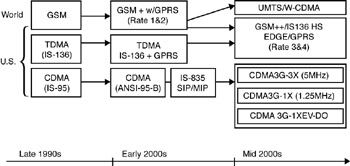
Figure 1-19: Wireless data evolution possibilities
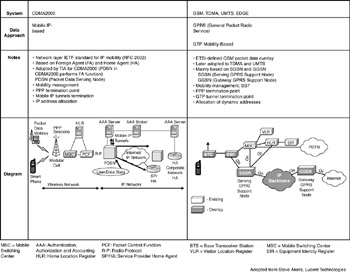
Figure 1-20: 3G examples
As carriers enhance their networks to prepare for 3G, they can offer early adopters upgraded data services. Labeled 2.5G because they fall between current 2G and 3G technology, these intermediary technologies (namely, GPRS and CDMA2000 1X) deliver data at rates between 115 and 307 Kbps. (2.5G WWAN systems supporting 50 to 150 Kbps will be available through 2003 and systems supporting 300 to 1,000 Kbps are expected to be available between 2003 and 2005.) When 3G is finally deployed, 2.5G systems can be replaced, but both carriers and end users must budget to replace the 2.5G devices and infrastructure.
As noted, GPRS is a packet-based technology for data transfer over an IP-based network and is used as an enhancement for GSM networks. With rapid session setup (0.5 to 1 second) and a data rate between 9 and 171.2 Kbps, GPRS is often said to be a very important step toward 3G. The speed of a GPRS-capable device depends on how many time slots (one to eight, shared by active users) are used within a TDMA frame. Uplink and downlink are treated separately and various radio channel coding schemes allow bit rates from 9 to over 171.2 Kbps per user (if a device were to use all eight channels without error correction). To make the most efficient use of network resources, GPRS provides dynamic sharing between speech and data services as well as for several profiles to make QoS decisions on how to treat packages (for example, video packages might be more time critical than packages resulting from normal WAP browsing).[49]
GPRS also supports the option for bandwidth-based billing. GPRS utilizes the same method for authentication and encryption used by GSM, but its techniques are optimized for packet data transmission. It also enables Short Message Service (SMS) transfer over GPRS radio channels. The technical specifications for GPRS are generated by the 3GPP. GPRS supports three modes of operating:
-
Class A GPRS and GSM services at the same time (one person can be on the phone with another individual while browsing WAP sites).
-
Class B Control channels for GPRS and GSM are monitored at the same time, but you can only use one service at one time.
-
Class C Exclusive GPRS operation.
Applications of GPRS include laptops or handhelds connected through a GPRS-capable cell phone or dedicated GPRS mode, mobile phones with a WAP browser, and dedicated equipment such as mobile credit-card swipers.
ETSI has also defined yet another standard called EDGE to support higher-speed data in GSM environments. EDGE is meant to be the basis for a 3G wireless standard that can be used by TDMA and GSM operators.[49] EDGE is an evolution of GPRS that will allow up to three times higher throughput compared to GSM using the same bandwidth. EDGE, in combination with GPRS, will deliver data services up to 384 Kbps in the near future in specific areas.[52] It works with a new modulation technique that enables better usage of existing frequencies. EDGE can be deployed on existing GSM networks and is part of the UWC-136 standard that TDMA carriers have proposed as their 3G standard of choice. EDGE enables data transfer speeds of up to 384 Kbps. This results in 48 Kbps per time slot enabling three times the data speeds of GPRS.
With GPRS implemented, the network parts that facilitate EDGE are located in the base station system (BSS). All you need is EDGE-capable transceiver unit (TRU) plug-ins and some software updates.[53] The upgrades that will be done on existing hardware are relatively small, implying the possibility of fast and cost-effective deployment of EDGE over GSM networks. EDGE-ready terminals are expected by the second half of 2002.
In summary,
-
GSM, TDMA, and cdmaOne IS-95A are 2G technologies.
-
GPRS and cdmaOne IS-95B are 2.5G technologies.
-
EDGE, W-CDMA, CDMA2000 1x, CDMA2000 1x EV-DO, and CDMA2000 1xEV-DV are 3G technologies.
The commercially reported migration paths to 3G in North America are as follows.[54] Cingular, AT&T Wireless, and Voice Stream have made a commitment to GSM/UMTS; this represents 48 percent of the U.S. wireless market at the time of this writing (Cingular has 20 percent, AT&T Wireless has 16 percent, Voice Stream has 5 percent, and other regional TDMA systems have 7 percent). Verizon and Sprint PCS have committed to CDMA2000; this represents 45 percent of the market (Verizon has 28 percent, Sprint has 10 percent, and other regional CDMA companies have 7 percent). Nextel, which uses iDEN, has not yet announced a 3G (it has, however, conducted tests with CDMA2000). The 3G era has already begun in the United States, but it's likely that the initial technology and services will fall short of expectations. In particular, very high-speed applications (see Figure 1-21) won't be well served until wideband 3G is deployed on a larger scale, which probably won't happen until after 2003.[55]
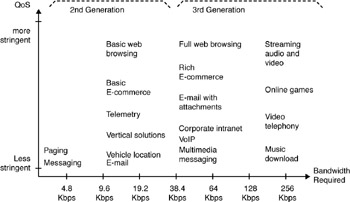
Figure 1-21: Bandwidth requirements based on applications
While Universal Mobile Telecommunications System (UMTS) has been championed by companies such as NTT DoCoMo, AT&T Wireless, Voice- Stream, and European Operators (bound to this technology by terms of their government licenses), CDMA2000 (backed by KDDI, Qualcomm, Sprint, and Verizon Wireless) has achieved an early lead. As of June 2002, 10 million subscribers were using CDMA2000 worldwide, compared with 112,000 for UMTS. There were 100 handset models for CDMA2000, but only 7 handset models for UMTS; the former cost $65 to 120, while the latter cost $240 to 400. Nonetheless, the world's largest operators and equipment vendors have invested billions of dollars in UMTS, so that the industry still favors UMTS as the long-term leader.
As we move to 3G, there is a strong desire to move to an all-IP environment. Figure 1-22[56] depicts one example of such a network from a topology standpoint. The transition from the current embedded base, however, will not be quick, inexpensive, or easy. With millions and even billions of mobile users, IP address space could become an issue. IP version 6 (IPv6) provides more space, but the adoption of IPv6 by service providers has been slow. Support in servers and in the core of the network (via IPv6/IPv4 encapsulation methods) is critical. Some people think that IPv6 has a heavier processing burden (for example, a wider address lookup, memory bandwidth issue, authentication/encryption processing, and so on).
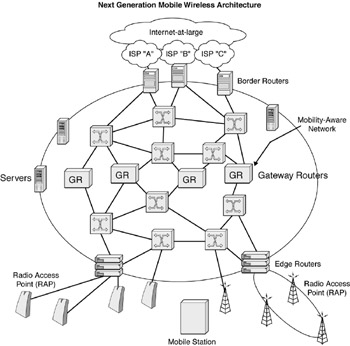
Figure 1-22: Future all-IP wireless WWANs (Source: Nortel Networks)
Transmission standards are only a part of the 3G wireless data solu- tion; delivery and data presentation technologies, including messaging, multimedia, and document representation standards, are still being developed. Successful new revenue opportunities for carriers depend on the carrier's ability to stimulate end-user interest (data services have to be perceived as being necessary) and the ability to make it simple for users to acquire and use the technology. (Integrated Services Digital Network [ISDN] and DSL have turned out to be the antithesis of user-friendliness in terms of being a plug-and-play technology.) Make the system work everywhere it is needed and articulate the value proposition. In an age of the positive bottom line, it is worth remembering that customer demand is enhanced by usefulness, not by technical sophistication of the core technology or the underlying protocols.
The good news is that hotspot operators do not have to wait for all of the complex and costly transition to take place (as summarized in Figure 1-23, which encapsulates the discussion of this entire subsection) to start collecting revenues from hotspot and nomadic networks. 3G will not replace the need for WLAN/WPAN-based hotspot technologies. 3G systems are wide area technologies, and although they have the advantage of seamless roaming, they offer much less bandwidth (2 Mbps at most and, more likely, at the practical deployment level, 384 Kbps for a long time to come). Hotspot services can also be designed to eventually support roaming with other wide area services when these become available. In summary, IEEE 802.11b and 802.11a may prove to be reasonable, presently available, and relatively inexpensive hotspot solutions for the short and intermediate term.
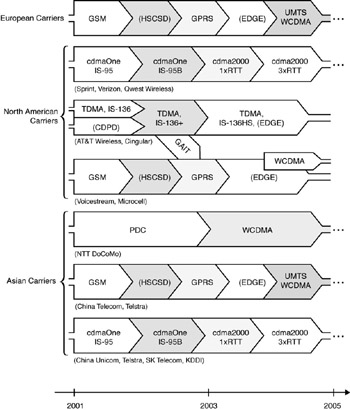
Figure 1-23: Hotspot services need not wait for complex evolution scenarios.
Fixed WWANs
Last-mile connectivity continues to be of interest. Only approximately 20,000 buildings in the United States have fiber facilities, and DSL services have seen relatively slow penetration in the past five years. Proponents are positioning wireless as a viable alternative to (wired) DSL, cable, and fiber-optic lines. Initially, line of sight (LOS) technology was more often than not point to point; today's advances allow for point-to-multipoint services. Point-to-multipoint techniques lower the cost of providing service. Some of these technologies can even support obstructed transmission paths, which are more common in typical communities.[32] Some vendors have coined the phrase 'wireless DSL' to refer to their service offering because they can provide fairly high-speed connections that are similar to various flavors of DSL. Some vendors (such as Sprint, StarTouch, and Air2LAN) also offer the significantly higher-speed connections via wireless, but at DSL pricing. Many of these offerings provide downlink speeds of 1 Mbps, whereas uplinks, in many cases, may be provided via a separate telephone line operating at 56 Kbps speeds.
The IEEE 802.16 Work Group is in the process of standardizing high-rate broadband-wireless access services to buildings through rooftop antennas from central base stations. The hope is that by integrating both mobile and fixed technologies, individuals will eventually be able to move around with a machine (such as a laptop, PDA, phone, and so on) and always have access to a data connection or VPN connection to the company LAN.
[37]This also includes infrastructures that use cellular telephony with antennas located in elevated mounts such as on tall buildings.
[38]IBM field technicians used mobile data terminals as early as the mid-1980s.
[39]B. Miller, 'The Phony Conflict: IEEE 802.11 and Bluetooth Wireless Technology,' IBM Promotional Materials, www-106.ibm.com/developerworks/wireless/library/wi-phone/, October 2001.
[40]www.watercove.com.
[41]In less than 10 years after the first GSM network was commercially launched, it became the world's leading and fastest growing mobile standard, spanning over 174 countries. Today, GSM technology issued by more than 1 in 10 of the world's population and growth continues to soar with the number of subscribers worldwide expected to surpass 1 billion by the end of 2003.
[42]C. Moore, 'The Race for Wireless Space,' InfoWorld (September 18, 2000): 43 ff.
[43]www.gsmworld.com/about/history_page1.html.
[44]www.novatelwireless.com/pressreleases/2001/story108.htm.
[45]www.cdg.org.
[46]www.novatelwireless.com/pressreleases/2001/story103.htm.
[47]reiter.weblogger.com/.
[48]T. Yager, 'Wireless Turbulence Ahead,' InfoWorld (September 18, 2000): 50 ff.
[49]Oliver Thylmann, www.infosync.no/show.php?id=1246, September 2, 2002.
[17]Matias Corporation, www.halfkeyboard.com.
[49]Oliver Thylmann, www.infosync.no/show.php?id=1246, September 2, 2002.
[50]www.novatelwireless.com/pressreleases/2001/story105.htm.
[51]These two figures are adapted from S. Akers, CTO, Lucent Technologies Inc., Integrated Network Solutions.
[49]Oliver Thylmann, www.infosync.no/show.php?id=1246, September 2, 2002.
[49]Oliver Thylmann, www.infosync.no/show.php?id=1246, September 2, 2002.
[52]http://www.nortelnetworks.com/solutions/providers/wireless/ gsm/edge.html
[53]www.ericsson.com/edge/how_it_works.shtml.
[54]This is based on information from Siemens, Merrill Lynch, Dresdner Kleinwort, JP Morgan, and Legg Mason.
[55]Observations by J. Grams, AT&T Wireless.
[56]Observations by Dr. Al Javed, CTO, Wireless Internet, Nortel Networks.
[32]www.wkmn.com/newsite/wireless.html.
|
|
EAN: N/A
Pages: 88